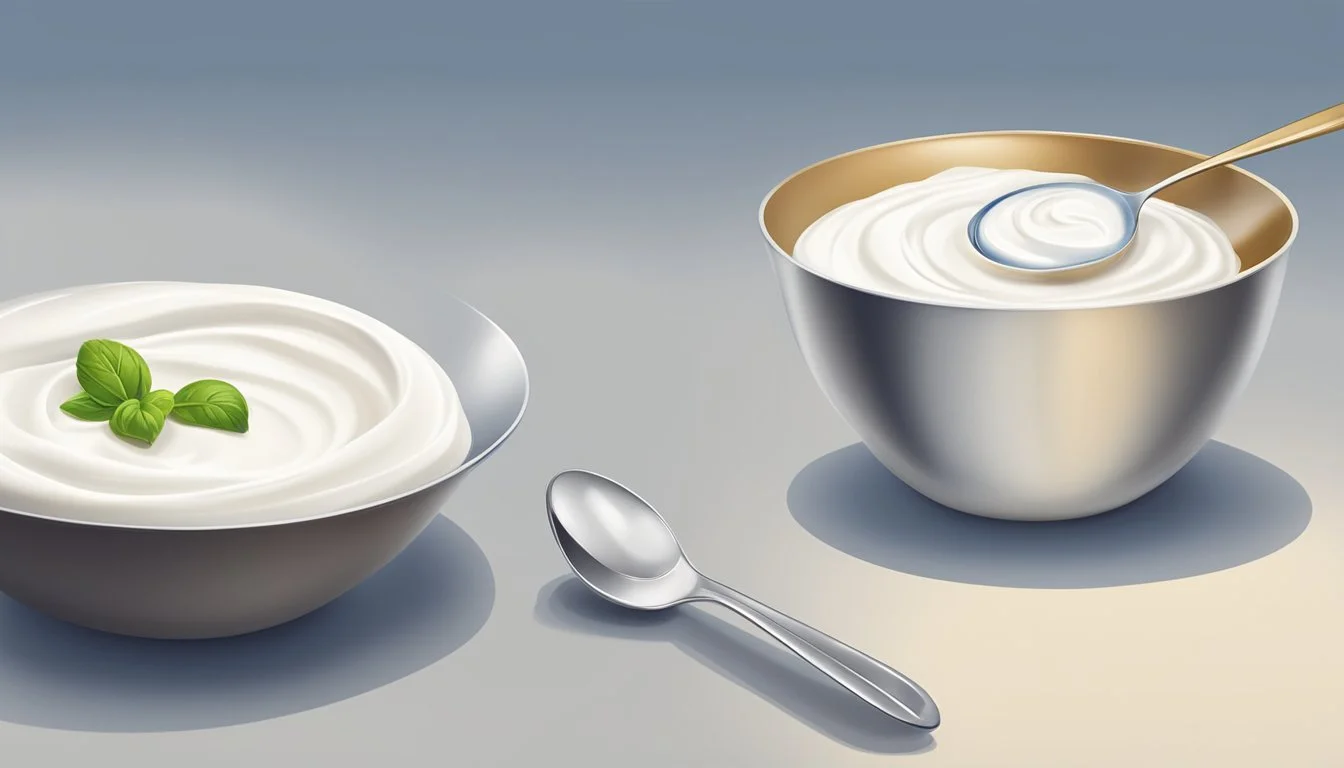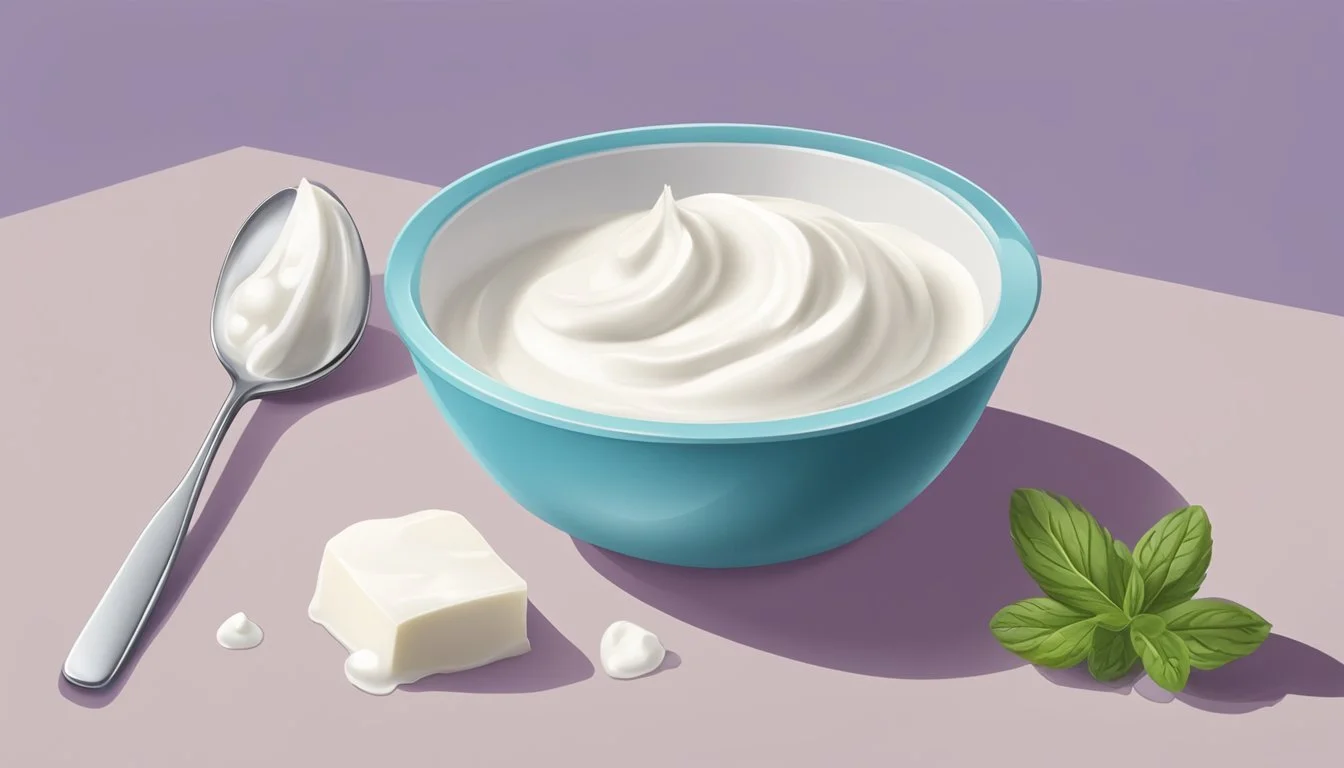How to Substitute Yogurt for Cream Cheese
A Simple Guide for Creamy Replacements
Substituting yogurt for cream cheese (how long does cream cheese last?)in recipes offers a way to decrease fat content and increase the nutritional value without sacrificing texture or taste significantly. When making the switch, it's essential to consider the properties of each dairy product. Cream (how long does cream last?) cheese (What wine goes well with cheese?) is known for its rich, creamy consistency and slightly tangy flavor, which is attributed to a high milkfat content and lower moisture levels. On the other hand, yogurt, especially Greek yogurt, which is preferred due to its thicker texture, contains more water and less fat, factors that can affect the end result of the dish if not adjusted properly.
To achieve a satisfactory substitute, selecting the right type of yogurt is crucial. Whole milk yogurt is the recommended choice as it mimics the fat content of cream cheese more closely than low-fat or non-fat alternatives. The consistency is also a vital component; yogurt tends to be more liquid than cream cheese. Hence, it may be beneficial to strain yogurt to reduce its water content and better replicate the texture of cream cheese. This method contributes to a more suitable substitute that maintains the desired structure and mouthfeel in recipes.
Understanding Cream Cheese and Yogurt
In exploring alternatives to cream cheese, it's crucial to comprehend the fundamental differences and nutritional aspects between cream cheese and yogurt. Both are dairy products derived from milk but have distinctive characteristics that affect their interchangeability in recipes.
Comparing Dairy Products
Cream Cheese is a soft, mild-tasting cheese with a high fat content, typically made by combining milk and cream. It exhibits a rich and creamy texture due to its approximate 33% fat content.
Yogurt, specifically whole milk yogurt, is made from fermented milk and has a considerably lower fat content, around 3.5%. Greek yogurt, a strained variety of regular yogurt, offers a thicker texture due to the removal of whey and can be closer to cream cheese in consistency.
Nutritional Profiles
Fat Content: This is a significant difference, with cream cheese having roughly 33% fat, while whole milk yogurt contains about 3.5%, and Greek yogurt varying but typically lower than cream cheese.
Protein: Yogurt is generally higher in protein than cream cheese. Greek yogurt is particularly protein-rich because the straining process removes the whey, concentrating the protein.
Calcium and Other Nutrients: Both dairy products offer calcium, but yogurt often provides more and also contains live cultures beneficial for digestive health. They can both contribute to a balanced intake of nutrients when consumed in moderation as part of a healthy diet.
Substituting Yogurt for Cream Cheese
When substituting yogurt for cream cheese, the choice of yogurt and consideration of fat content are crucial to closely match the texture and flavor of cream cheese.
General Substitution Guidelines
In recipes, Greek yogurt can often stand in for cream cheese. To substitute, one should use 3/4 cup of Greek yogurt for every cup of cream cheese needed. For best results, it's recommended to use strained Greek yogurt, which has excess whey removed, mimicking the thicker texture of cream cheese. Keep in mind, Greek yogurt is tangier, so one might need to adjust flavors accordingly.
Choosing the Right Type of Yogurt
For a substitution that respects the fats and consistency of cream cheese, whole milk yogurt is the ideal choice. This type of yogurt typically contains around 3.5% fat, a crucial aspect since cream cheese boasts a fat content of about 33%. Yogurt should be plain to avoid adding unwanted sweet or flavored undertones to the dish being prepared. Using plain, whole milk yogurt creates a cream cheese substitute that is closer in consistency and flavor to the original ingredient, providing a more reliable outcome in the final dish.
Culinary Considerations
When substituting yogurt for cream cheese, one must consider the textural and flavor implications to ensure a successful culinary outcome. Key elements like texture and consistency, as well as flavor and tanginess, need careful balancing to mirror the properties of cream cheese in recipes.
Texture and Consistency
Cream cheese is known for its thick, spreadable nature which is a result of its high milkfat content and low moisture levels. Substituting with yogurt, one should aim for a similar density to maintain the integrity of a dish. Greek yogurt, with its strained, thicker consistency, is often the ideal choice as it more closely mimics the texture of cream cheese. To further approximate the richer texture of cream cheese, one can strain regular whole milk yogurt to reduce moisture:
Use a cheesecloth or a coffee filter to strain yogurt.
Place over a bowl in the refrigerator for 12 hours to allow whey to drain.
This process yields a firmer yogurt with less water content, closer to that of cream cheese.
Flavor and Tanginess
In terms of flavor, cream cheese has a mild, slightly tangy profile. Yogurt tends to be tangier, given its natural fermentation process, which should be considered in recipes to ensure the flavor profile remains balanced. Avoid flavored or sweetened varieties; instead, opt for plain, whole milk yogurt to provide a subtle tang without overpowering the dish. If a milder taste is needed, one might consider adding a small amount of cream to the strained yogurt to soften the tanginess.
When used in cooking, the natural tanginess of yogurt can complement the existing flavor profile, particularly in dips and spreads. However, for sweet dishes where a neutral flavor is desirable, the tanginess should be mitigated by using less yogurt or blending it with milder ingredients like sour cream.
Recipes and Cooking Applications
When substituting yogurt for cream cheese in recipes, chefs should consider the moisture content and fat percentage to maintain the desired texture and flavor of the dish. Greek yogurt is often a preferred choice due to its thicker consistency and higher protein content, which can better mimic the properties of cream cheese when used in various culinary applications.
Baking with Yogurt as a Substitute
In baking, the rich texture and high fat content of cream cheese are often essential for the structure and flavor of the finished product. When using Greek yogurt as a substitute, one should aim to maintain the original fat content of the recipe. To achieve this, whole milk Greek yogurt is recommended. It can be used successfully in recipes like cheesecakes or as a tangy addition to frostings. For every cup of cream cheese, one can use an equal amount of Greek yogurt, though slight modifications may be necessary for optimal results.
Example Cream Cheese Greek Yogurt Cheesecake 1 cup 1 cup Frosting 1 cup 1 cup with possible sweetener adjustment
Cooking and Creaminess
In cooking, especially when creating creamy textures, cream cheese brings a thickness that can elevate dishes like Alfredo sauce or creamy soups. Substituting with yogurt requires attention to the cooking process to avoid curdling. Low heat is imperative, and strain the yogurt if extra thickness is desired. Greek yogurt works well in dips, maintaining creaminess with a lighter, more tangy profile.
Alfredo Sauce: Use strained Greek yogurt in place of cream cheese on low heat, stirring until smooth.
Dips: Substitute directly with Greek yogurt to achieve a similar creamy consistency with a lighter taste.
Creative Recipe Adaptations
For creative cooks, the substitution of yogurt for cream cheese opens up new possibilities. One can experiment with savory or sweet dips, or even adapt baking recipes like piña colada cupcakes by using yogurt for a tropical twist in the frosting. In these cases, the slight tanginess of yogurt can complement the other flavors in the dish, making for a distinctive and enjoyable taste experience.
Piña Colada Cupcakes: Replace cream cheese frosting with a Greek yogurt variation, integrating pineapple juice and coconut for a unique flavor combination.
Savory Dips: Greek yogurt can be blended with herbs and spices to create dips that are both light and flavorful, suitable for pairing with vegetables or pita bread.
Alternative Cream Cheese Substitutes
While yogurt can be a substitute for cream cheese, other alternatives can also be used depending on the recipe requirements and dietary preferences. The following substitutes offer a range of flavors and consistencies that can complement various dishes.
Dairy-Based Alternatives
Dairy-based alternatives provide a flavor and texture similar to cream cheese and are suitable for those who do not have dairy restrictions. Here are some key dairy-based substitutes:
Mascarpone: It's creamier and richer, making it ideal for desserts requiring a smooth texture.
Neufchâtel: It has a lower fat content than cream cheese and boasts a similar taste and texture.
Ricotta: Perfect for fillings and dips when mixed with yogurt to achieve a creamier consistency.
Non-Dairy and Vegan Options
For vegans or those with dairy intolerances, several non-dairy substitutes mimic the texture and taste of cream cheese:
Vegan Cream Cheese: Comes in various bases such as soy, almond, and coconut, suitable for spreads and dips.
Tofu: Silken tofu can be blended with lemon juice and oil for a dairy-free spread or dip.
Almond Cream Cheese: Made from almonds, it offers a nuttier flavor ideal for spreads.
Coconut Cream Cheese: This provides a tropical twist to recipes and works well in desserts.
Cashew Cream Cheese: It has a creamy texture and is commonly used in vegan recipes for its smoothness.
Health Considerations
When substituting yogurt for cream cheese, individuals often consider the health impacts, particularly regarding calories and fat intake, as well as seeking a protein-rich alternative with healthier ingredients.
Calories and Fat Intake
Calories: Cream cheese contains significantly higher calories compared to yogurt. For a healthier version, one might choose yogurt as it offers fewer calories per equivalent serving.
Fat Content:
Cream Cheese: Approx. 33% fat content
Whole Milk Yogurt: Approx. 3.5% fat
Greek Yogurt: Generally less fat than cream cheese
Choosing plain, whole milk or Greek yogurt can lead to lower fat intake compared to using cream cheese. Substitutes like low-fat or non-fat yogurt offer the least fat per serving, but the consistency may significantly differ from cream cheese.
Protein and Healthier Ingredients
Protein-Rich: Greek yogurt is especially known for being protein-rich, with more protein per serving compared to regular yogurt or cream cheese, contributing to a feeling of fullness and muscle maintenance.
Healthier Ingredients: Yogurt often incorporates probiotics and can be a source of calcium. The use of yogurt, especially the non-flavored, plain varieties, avoids the addition of extra sugar and preservatives commonly found in flavored cream cheese products.
Food Science and Culinary Education
Substituting yogurt for cream cheese involves a good grasp of food science and applying such understanding in the kitchen. This section provides insights into the fundamental scientific principles and valuable resources for culinary education related to this substitution.
The Role of Lactic Acid
Lactic acid bacteria play a vital role in the development of yogurt’s tangy flavor. These bacteria ferment the lactose in milk, producing lactic acid which not only adds flavor but also contributes to the thickening of the milk as it transforms into yogurt. For cream cheese, lactic acid is also present due to similar fermentation processes, which impacts the final product's taste and texture.
Understanding Whey and Curds
During the cheese-making process, milk is separated into solid curds and liquid whey. Cream cheese results predominantly from the curds, with most of the whey removed, which is why it has a higher milkfat content and denser texture than yogurt. In contrast, yogurt typically contains a higher quantity of whey, contributing to its moisture content and creamier consistency. This fundamental difference affects how yogurt can act as a substitute for cream cheese in recipes:
Yogurt: Higher moisture content due to whey
Cream cheese: Denser from curds, less whey
Educational Tutorials and Videos
For those seeking a practical education in substituting yogurt for cream cheese, a plethora of tutorials and videos are available. They offer step-by-step guidance on how to properly strain yogurt to reduce whey content, achieving a thickness closer to that of cream cheese. These visual aids can demonstrate techniques such as:
The straining process using cheesecloth or a fine-mesh sieve
Adjusting yogurt quantities in recipes to mimic the consistency of cream cheese
By leveraging these resources, cooks can better understand the texture modifications and taste adjustments required when making this dairy substitution.
Practical Tips for Kitchen Preparation
When substituting yogurt for cream cheese, one should pay close attention to storage and handling, as well as be open to a bit of cooking experimentation to achieve the best results.
Storage and Handling
Storing the yogurt correctly is essential for maintaining its quality and suitability as a cream cheese substitute. Yogurt should be kept in the refrigerator at a temperature between 35°F to 40°F to ensure freshness and prevent spoilage. For optimal use, store yogurt in air-tight containers to maintain its texture and prevent it from absorbing odors from other foods.
Before use: Ensure that the yogurt is well within its expiration date and has been stored correctly.
Preparation: If the yogurt is too watery, it can be strained through cheesecloth or a coffee filter in a strainer to achieve a thicker consistency closer to that of cream cheese.
Cooking Experimentation
Substituting yogurt for cream cheese involves an element of experimentation. The cook may need to adjust the amount of yogurt used or mix with other ingredients to achieve the desired taste and texture in recipes.
Fat content: Opt for whole milk yogurt to better mimic the richness of cream cheese.
Consistency: Adjust the thickness by straining the yogurt if necessary, as mentioned above.
By considering these practical tips during kitchen preparation, one can confidently use yogurt as a cream cheese alternative, yielding satisfactory results across various recipes.






